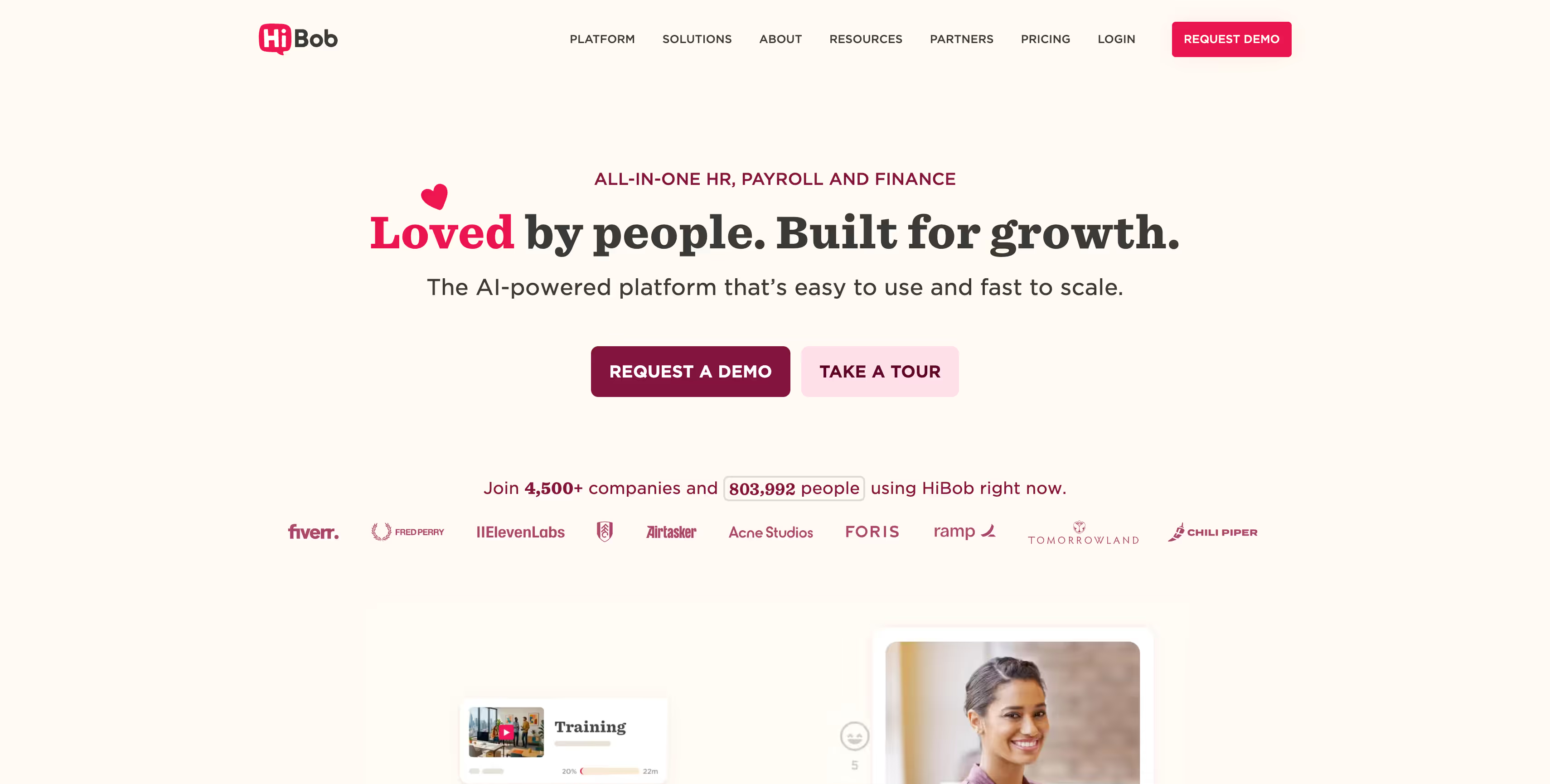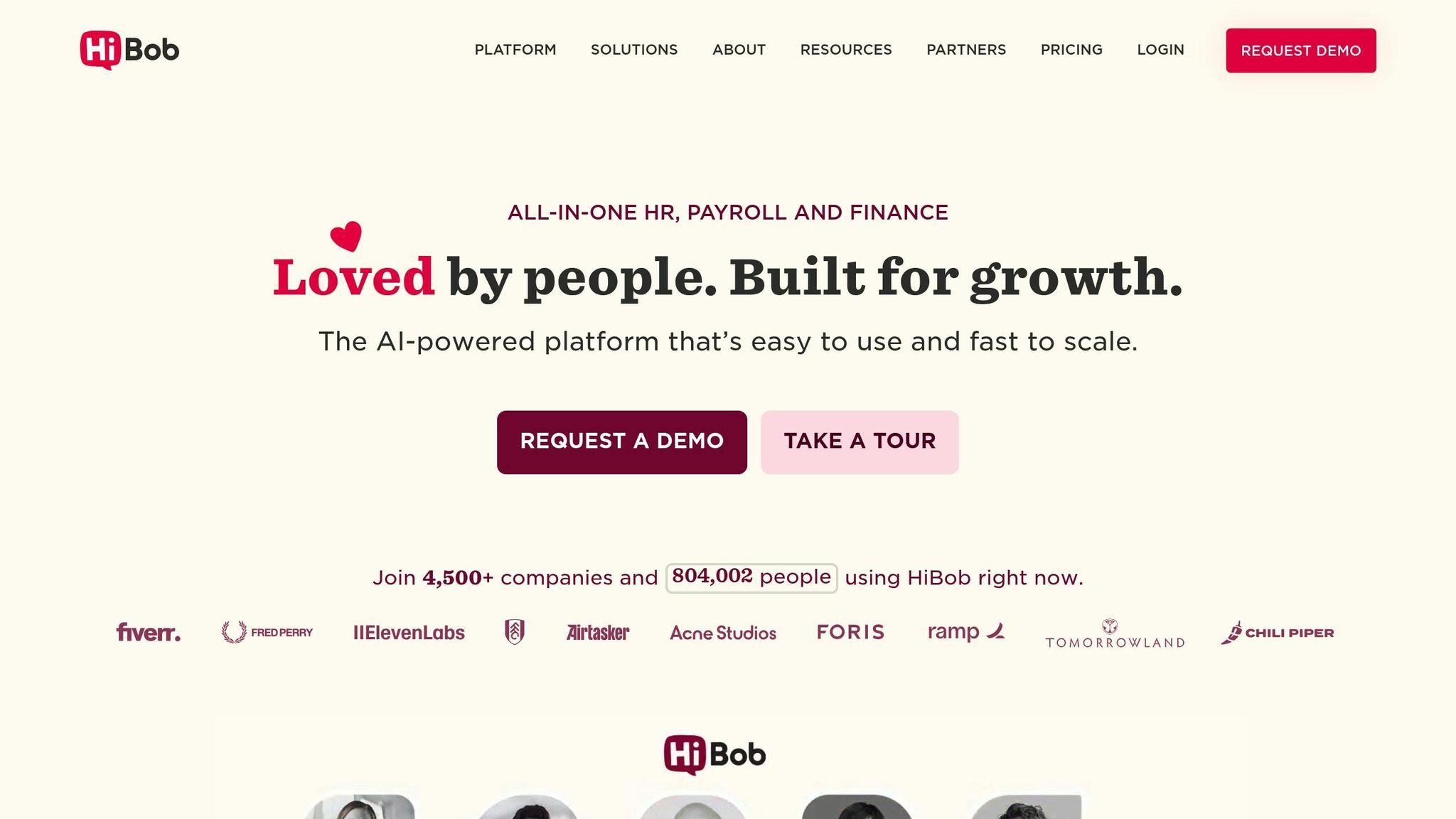HiBob Review 2026: A Deep Dive Into Features, Pricing, and Competitors

HiBob continues to thrive as a leading HR platform for mid-sized and global companies in 2026, offering tools that simplify HR processes while focusing on employee engagement. Known for its user-friendly design and global compliance support, HiBob is particularly suitable for distributed teams and organizations that manage employees across multiple locations.
Key Takeaways:
- Target Audience: Best for mid-sized to large companies with distributed or international teams.
- Features: Includes employee management, real-time analytics, goal tracking, leave management, and integrations with tools like Slack and Gusto.
- Pricing: Custom quotes based on company size and needs; typically $8–$12 per employee/month for smaller teams.
- Strengths: Intuitive interface, strong analytics, and global compliance capabilities.
- Challenges: Pricing transparency and technical setup for some integrations.
HiBob stands out for its focus on improving workplace experiences and its ability to support global operations. However, smaller businesses or those seeking upfront pricing may find it less suitable.
HiBob Full Platform Demo 2025: The Ultimate HCM Tool for Modern HR Leaders

What Is HiBob (Bob)?
HiBob (also known as Bob) is a cloud-based HR Information System (HRIS) established in 2015, with headquarters in London and New York. Designed to address the needs of today’s dynamic workplaces, HiBob is particularly well-suited for distributed teams.
Unlike traditional HR systems, HiBob focuses on more than just data management. It takes a people-first approach, blending essential HR operations with tools that enhance employee experience and workplace culture. The platform aims to help organizations not only streamline HR processes but also foster stronger, more connected teams.
HiBob primarily serves mid-sized to large enterprises seeking advanced people management tools without the complexity of traditional enterprise HR systems. It’s particularly appealing to organizations managing employees across multiple locations, thanks to its compliance features tailored for international teams. At the same time, its culture-focused tools are designed to keep dispersed teams engaged and connected [1][2].
Tech companies and startups make up a significant portion of HiBob’s clientele. These companies are drawn to its emphasis on employee engagement, which aligns with their people-first values. Additionally, HiBob integrates seamlessly with the tech ecosystems these organizations often rely on [1].
"HiBob's intuitive interface stands out, making it easier for HR teams and employees to adopt without a steep learning curve", says Imed Bouchrika, Co-Founder and Chief Data Scientist at Research.com [1].
One of HiBob's standout features is its robust analytics and reporting tools, which empower HR teams to make strategic decisions. These tools support better workforce planning, retention strategies, and performance management, giving organizations the insights they need to optimize their HR efforts.
HiBob also includes features that prioritize employee well-being and engagement. Tools for recognition programs, employee surveys, and internal communication help businesses create a sense of belonging among their teams. This makes HiBob an excellent choice for companies that value workplace culture as much as operational efficiency [1].
The platform has earned high ratings from users, with scores of 4.6/5 on Capterra, 4.5/5 on G2, and 4.0/5 on Glassdoor. These ratings reflect its reputation as a reliable and effective HR solution [2].
"Bob's comprehensive coverage of HR functions like onboarding, time tracking, and performance management means I don't have to juggle multiple systems", adds Bouchrika [1].
HiBob positions itself as a modern solution that bridges the gap between traditional HR management systems and tools focused on enhancing the employee experience. It’s an appealing option for organizations looking to elevate their approach to people management in the years ahead. This introduction lays the groundwork for a deeper dive into HiBob's features and capabilities.
HiBob Key Features (2026)
HiBob offers a suite of tools designed to simplify modern HR challenges while keeping the user experience intuitive and engaging. It combines essential HR functionalities with features that nurture company culture and boost employee engagement. Here's a closer look at its core features.
Core HR & Employee Management
HiBob centralizes employee information into detailed profiles and real-time org charts, showcasing skills, career goals, and team structures. This comprehensive view helps HR teams and managers make informed decisions quickly.
A self-service portal allows employees to handle tasks like updating personal details, requesting time off, or accessing pay stubs - all from one place. This reduces HR's workload and gives employees instant access to the resources they need.
The platform’s employee directory features advanced search and filtering tools, making it easy to locate colleagues by skills, department, location, or project involvement. This is especially useful for larger organizations where employees might not be familiar with everyone across teams or offices.
These tools work seamlessly with HiBob's analytics capabilities, which are discussed in the next section.
People Analytics & Reporting
HiBob’s analytics dashboard transforms HR data into practical insights. Pre-built reports cover key metrics like headcount trends, turnover rates, employee satisfaction, and performance. Customizable dashboards let users zero in on metrics most relevant to their roles.
Predictive analytics add another layer of value by identifying potential issues before they escalate. For instance, the system can flag employees at risk of leaving based on engagement levels, performance patterns, and other indicators. This helps HR teams act proactively to improve retention.
The reporting tools also include diversity and inclusion tracking. Organizations can analyze hiring trends, promotion rates, and pay equity across demographic groups to identify areas needing attention. These insights support efforts to create a more equitable workplace.
HiBob’s analytics not only inform decisions but also tie into its performance and goal-setting tools.
Performance & Goals Management
HiBob moves beyond traditional annual reviews with a continuous performance tracking system. Managers and employees can schedule regular check-ins, monitor goal progress, and exchange real-time feedback throughout the year.
The platform’s OKR (Objectives and Key Results) management aligns individual goals with broader company objectives. Employees can see how their contributions fit into the bigger picture, fostering alignment and motivation. Progress tracking is straightforward, with visual indicators showing goal status at a glance.
360-degree feedback tools collect input from peers, managers, and direct reports, offering a well-rounded view of an employee’s performance and development areas. The process is customizable, allowing companies to adapt it to their specific needs.
HiBob also provides 1:1 meeting templates and agenda tools, ensuring manager-employee discussions are structured and productive while maintaining consistency across teams.
Time Off & Attendance
HiBob simplifies leave management with tools that handle complex policies automatically. Companies can create tailored leave policies for different employee groups, locations, or contract types. The system tracks various leave categories - vacation, sick days, personal time - while adhering to local regulations.
Approval workflows are automated, routing requests to the appropriate managers based on company policies. The system supports multiple approval levels, delegates authority when needed, and updates team calendars automatically once requests are approved.
Localized compliance ensures holiday calendars, minimum vacation requirements, and other time-off rules align with local laws, making it ideal for businesses with a global workforce.
A team calendar view provides managers with a clear picture of team availability, aiding in project planning, meeting scheduling, and ensuring coverage during busy periods or when multiple team members are away.
Integrations & API
HiBob integrates with popular communication tools like Slack and Microsoft Teams, allowing employees to request time off, view announcements, and access HR resources without switching apps.
Payroll integrations with platforms like Gusto, ADP, Deel, and PayFit sync employee data, time-off records, and payroll-related information automatically. This reduces manual data entry and minimizes payroll errors.
The platform’s open API enables businesses to create custom integrations with their existing systems, whether it’s CRM tools, project management software, or financial applications.
HiBob also supports single sign-on (SSO) with identity management systems like Okta, Azure Active Directory, and Google Workspace. Additional integrations extend to recruiting platforms, learning management systems, and employee survey tools, creating a connected and efficient HR ecosystem.
User Experience & Interface
HiBob provides an easy-to-navigate and well-designed interface that simplifies tasks for HR teams. It helps streamline workflows, automate repetitive tasks, and organize documentation in one central hub for quick access[3]. This straightforward design complements its extensive features, paving the way to explore its pricing structure in more detail.
HiBob Pricing (2026)
HiBob uses a personalized pricing model that adjusts based on factors like company size, selected modules, and the geographic distribution of the workforce. Unlike many HR platforms with standard pricing tiers, HiBob asks potential customers to connect with their sales team for a custom quote tailored to their specific needs.
This approach, while not openly transparent, ensures businesses only pay for the features they actually use. It’s particularly helpful for smaller companies that might not need the full suite of advanced tools.
HiBob is positioned in the mid-to-high range of HRIS providers. For smaller teams (20–100 employees), pricing typically falls between $8 and $12 per employee per month for essential HR features. Larger organizations or those with global operations receive custom enterprise pricing, which often includes extras like dedicated customer success managers, advanced analytics, and tools to handle compliance across multiple countries.
The platform also offers optional add-ons, such as premium performance management, advanced analytics, and engagement tools. These come at an extra cost per employee, adding more flexibility for businesses that want to expand their capabilities.
For companies with an international workforce, regional requirements like payroll integration, compliance, and localization can drive up costs. For example, a U.S.-based company with 100 employees will likely pay less than a company with the same headcount spread across multiple countries.
One of HiBob's strengths is its commitment to free demos and consultation calls. These sessions allow potential customers to explore the platform in detail and discuss their specific needs with the sales team before receiving a formal quote. Most clients opt for annual contracts, which offer better rates per employee. Implementation fees are typically bundled into the first-year costs, though complex global deployments may require additional services.
This pricing structure, combined with HiBob's extensive features and user-focused design, gives businesses a clear understanding of what to expect when upgrading their HR systems.
sbb-itb-88a7fe6
HiBob Pros and Cons
When deciding whether HiBob aligns with your HR needs, it's essential to weigh its advantages and limitations.
One of HiBob's standout features is its modern and intuitive interface. Its visually appealing design makes it easy to navigate, encouraging regular use. This not only boosts adoption rates but also minimizes the time and effort required to train HR staff.
HiBob also excels in analytics and reporting. With real-time dashboards and customizable reports, HR teams can identify trends in areas like headcount, attrition, and engagement. These insights are invaluable for strategic workforce planning, especially for data-driven organizations.
For companies with distributed teams, HiBob's global HR support is a game-changer. The platform simplifies operations across multiple countries by handling compliance, localized leave policies, and payroll integrations. This makes it particularly appealing for international businesses managing diverse teams.
That said, HiBob does come with some challenges. Its pricing model lacks transparency, which can make budgeting tricky. Additionally, some integrations require technical expertise, potentially delaying implementation for companies without dedicated IT resources.
Another consideration is that advanced features are often tied to higher-tier plans. This can lead to unexpected expenses for organizations looking to leverage advanced analytics or performance management tools.
Lastly, HiBob's comprehensive feature set and pricing structure may not be the best fit for very small businesses. Companies with fewer than 20 employees might find the platform too robust and costly for their needs.
Here’s a quick summary of HiBob’s strengths and challenges:
Pros and Cons Comparison Table
| Pros | Cons |
|---|---|
| Modern, user-friendly design that promotes regular use | Pricing lacks transparency |
| Advanced analytics with real-time insights for better decision-making | Some integrations require technical setup |
| Excellent global HR support for compliance and payroll | Advanced features often require higher-tier plans |
| Highly customizable workflows and permissions | May be too complex and expensive for businesses with fewer than 20 employees |
| Comprehensive tools for engagement and culture-building |
Customer Support & Onboarding
HiBob takes a personalized approach to customer support that stands out from many traditional HRIS platforms. Instead of relying on impersonal ticket-based systems, HiBob assigns dedicated support representatives to each client, offers live chat for real-time assistance, and has specialized onboarding teams to guide new customers through the implementation process[5][6].
This support model focuses on proactive guidance and immediate help, reducing the common frustrations associated with older systems[6]. This is especially helpful for companies operating across multiple countries, where compliance and localization challenges can complicate HR processes.
HiBob’s onboarding specialists work hands-on with new clients to manage everything from initial setup and data migration to workflow configuration. Their experience across various industries and company sizes enables them to adapt the implementation process to fit each organization’s unique needs[6]. The onboarding process also incorporates customizable automated workflows for tasks like pre-day paperwork, team introductions, and training assignments[4][5].
To further assist users, HiBob provides a comprehensive help center and resource library packed with searchable articles, step-by-step guides, and video tutorials[8]. The platform’s user-friendly, social media–inspired interface is another big plus, as it shortens training time and encourages daily use[4]. Together, these resources contribute to the smooth onboarding experience that many users have praised.
Customer feedback often highlights the seamless onboarding process, with many applauding the responsiveness and expertise of HiBob's support team[4][6]. However, global implementations can sometimes present challenges. Complex setups involving multiple countries, compliance requirements, and intricate integrations may require more time and coordination. Regional differences in payroll, benefits, and regulations can also add layers of complexity, but HiBob’s team actively works to address these issues[4][6].
Take Magma Math, for example. As an early adopter of HiBob’s payroll and benefits module, the company benefited from a well-executed implementation led by HiBob's onboarding team. The process not only simplified their decision to switch but also unified payroll and people analytics across their international operations. Employees even requested the platform proactively, showcasing its appeal and effectiveness in managing complex, global rollouts[6].
HiBob’s customer success strategy goes beyond basic support, aiming to build long-term partnerships. The company offers ongoing training, webinars, and community forums to help clients make the most of the platform[8].
It’s worth noting that the quality of support and onboarding can vary depending on the complexity of the implementation. Companies with straightforward, single-country setups usually experience quicker onboarding, while those with multi-country operations or extensive customization needs should anticipate a more collaborative and detailed process with HiBob’s specialists.
HiBob Competitors Overview
HiBob stands out with its focus on employee engagement and sleek, modern design. It’s a great fit for mid to large global teams that prioritize fostering a dynamic workplace culture and need a wide range of HR tools. On the other hand, BambooHR caters to small and medium-sized businesses, offering a simple and user-friendly HRIS solution that emphasizes core HR management.
HiBob vs. BambooHR

| Platform | Best For | Key Strengths |
|---|---|---|
| HiBob | Mid to large global teams that value culture and engagement | User-friendly interface, robust HR tools, data-driven insights |
| BambooHR | Small to medium businesses seeking simplicity | Easy-to-use HR management, quick setup, straightforward features |
This comparison highlights HiBob’s strong appeal for larger companies focused on engagement and cultural development, making it clear which organizations are best suited for its capabilities.
Who Should Use HiBob in 2026?
HiBob in 2026 is tailored for mid-sized to large organizations and HR teams looking for more than just basic record-keeping. It’s an ideal choice for companies that value modern, user-friendly tools and need robust features to manage distributed or global teams effectively.
For businesses operating across multiple countries, HiBob’s global support is a standout feature. It simplifies compliance and reporting by accommodating multi-country regulations, localized leave policies, and unified data management. The platform is built to handle complex setups, ensuring employees in different locations are managed efficiently while adhering to local labor laws and workplace norms.
Companies that emphasize employee experience and aim to foster a strong workplace culture will find HiBob especially useful. Its tools for mood tracking, employee recognition, and advanced analytics make it a great fit for organizations focused on engagement and data-driven decision-making. This makes HiBob particularly appealing to tech companies, creative agencies, consulting firms, and other industries that rely on retaining top talent.
For growing businesses, HiBob offers flexibility to scale alongside their needs. Whether it’s rapid headcount growth, international expansion, or shifting HR requirements, the platform can adapt as those needs evolve. Its customization options make it a strategic choice for organizations planning for the future.
That said, HiBob isn’t for everyone. Companies with very tight budgets or those that prefer upfront, transparent pricing might find the custom quote process challenging. Additionally, implementing the platform requires some technical know-how and a willingness to embrace change. Teams hesitant about adopting new technology may face hurdles during the transition.
In short, HiBob is best suited for forward-thinking organizations ready to invest in a comprehensive HR solution that enhances employee engagement and supports global operations. However, it may not align with every company’s budget or operational style.
Conclusion
As of 2026, HiBob stands out with its user-friendly design, advanced analytics, and comprehensive global HR tools tailored for managing compliance and data across multiple countries. Throughout this review, its strengths have been highlighted through real-world examples and industry accolades.
The platform's real-time dashboards provide actionable insights into areas like headcount, attrition, and employee engagement. Its seamless integration capabilities streamline HR and payroll processes, making it especially valuable for companies managing distributed teams across various regions. Localized compliance features and unified data management add an extra layer of convenience for global operations.
Magma Math, one of the early adopters of HiBob's payroll and benefits module, shared that the platform successfully unified payroll and people analytics across international branches, enhanced workflow accuracy, and was the first HR system that employees actively requested to use[6].
However, there are a few challenges to consider. HiBob's pricing transparency remains somewhat limited, and advanced integrations may require additional setup. Despite these hurdles, the platform's widespread adoption highlights its impact and effectiveness.
With over 4,500 companies relying on HiBob to support 804,000 employees[5], its market presence is undeniable. Experts from Sapient Insights Group and HR Tech Outlook have commended HiBob for its employee-centric design, AI-driven analytics, and ability to streamline HR processes[6][7].
To see if HiBob aligns with your organization's needs, consider requesting a personalized demo. This allows you to explore its interface, evaluate features suited to your company's size and geographic footprint, and receive a tailored pricing plan. Ultimately, HiBob's suitability depends on your organization's complexity, growth trajectory, and commitment to adopting a robust HR solution that prioritizes both employee engagement and operational efficiency.
FAQs
How does HiBob help companies stay compliant with international HR regulations?
HiBob streamlines global HR compliance by providing tools designed for multi-country payroll, managing labor laws specific to each region, and staying updated with regulatory changes. It helps businesses navigate localized policies like leave tracking, tax regulations, and holiday observances across various countries. This allows companies with a dispersed workforce to align with international requirements while cutting down on administrative complexities.
What features does HiBob provide to boost employee engagement and workplace culture?
HiBob provides a variety of tools aimed at boosting employee engagement and improving workplace culture. These tools include anonymous surveys to collect honest feedback, mood tracking to keep an eye on employee sentiment, and recognition features like shoutouts and celebrations to promote appreciation among team members. On top of that, HiBob’s built-in engagement surveys are designed to help businesses cultivate a more connected and motivated work environment as they move forward into 2026.
How is HiBob priced, and what factors determine the cost for businesses?
HiBob follows a per-employee-per-month (PEPM) pricing structure, generally falling between $16 and $25. The exact price varies based on factors such as the size of the company, its location, the modules chosen (like performance, engagement, or onboarding), and the extent of customization needed.
For larger companies or those requiring advanced features and integrations, HiBob typically provides custom pricing. Since their pricing details aren’t publicly available, businesses are advised to schedule a consultation to receive a personalized quote.
Related Blog Posts
Read also
Ready to get started?
If you want to dive into the details just Book a Free Consultation with our staff and we’ll be happy to answer your questions.





